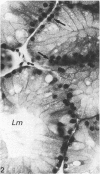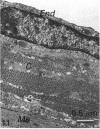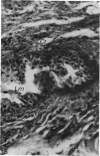Abstract
The harderian gland in the Wistar rat consists of tubules with wide lumina lined by a single layer of columnar epithelial cells possessing myoepithelial cells within their basal laminae. The gland contains porphyrin pigment which is stored as solid intraluminal deposits. The glandular epithelium possesses 2 cell types, termed A and B. These are characterised by an extraordinarily well-developed tubular smooth endoplasmic reticulum and numerous lipid vacuoles. Type A cells can be distinguished from type B by the number, size and content of the lipid vacuoles. Type A cells are more numerous. They contain large lipid vacuoles with dense ribbon-like material identical in form to the material in the luminal masses of porphyrin pigment, whereas those of type B cells are small with crescentic dense lamellar material. The content of the vacuoles is essentially released by exocytosis, but holocrine secretion also occurs. The lipids and the ribbon-like material represent the bulk of the intraluminal secretory product. The secretion of porphyrins seems to be associated with type A cells. The single excretory duct is lined by a stratified epithelium. The duct epithelium comprises serous cell types, designated C1 and C2 and scarce mucus-secreting cells. Type C1 cells are characterised by numerous dense granules, whereas type C2 cells are distinguished by lysosomal structures. Fibroblasts, macrophages, mast cells, plasma cells, fenestrated capillaries and unmyelinated axons are frequently observed in the connective tissue. The gland is surrounded by a collagenous capsule and an outer layer of endothelial cells of the orbital venous sinus.
Full text
PDF



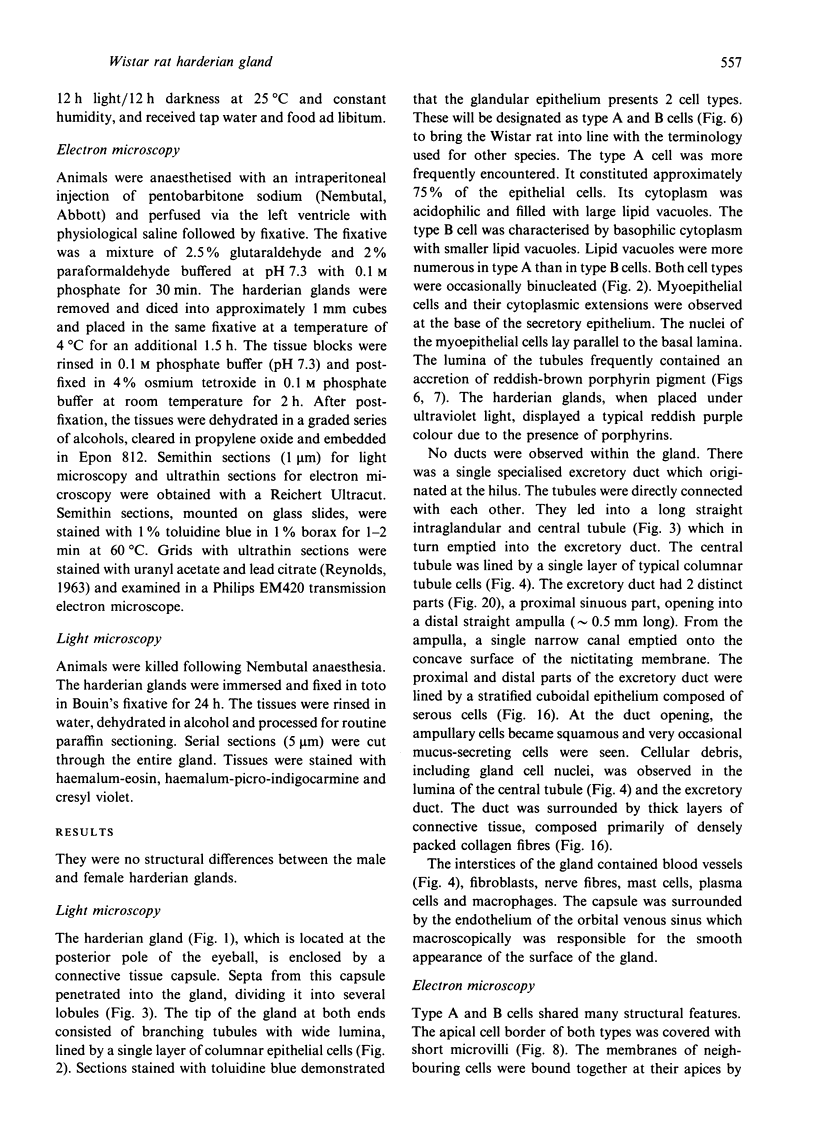




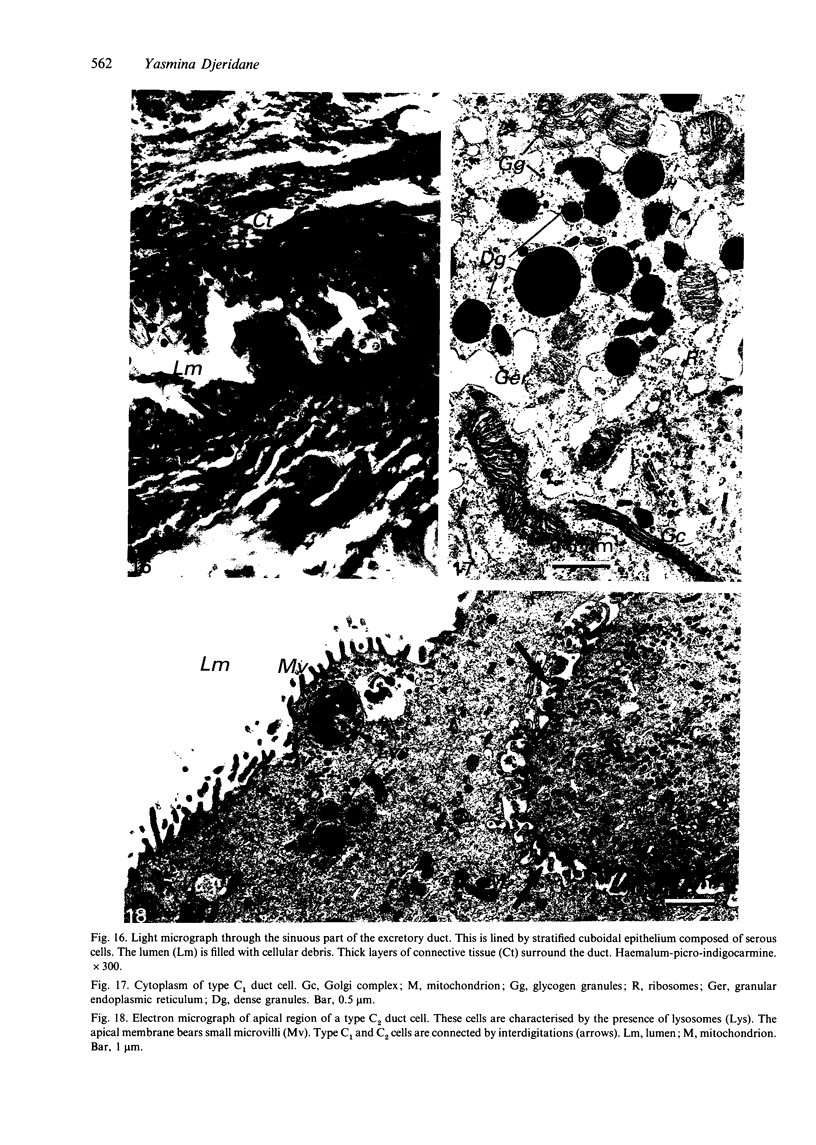




Images in this article
Selected References
These references are in PubMed. This may not be the complete list of references from this article.
- BJOERKMAN N., NICANDER L., SCHANTZ B. On the histology and ultrastructure of the Harderian gland in rabbits. Z Zellforsch Mikrosk Anat. 1960;52:93–104. doi: 10.1007/BF00344641. [DOI] [PubMed] [Google Scholar]
- Brownscheidle C. M., Niewenhuis R. J. Ultrastructure of the harderian gland in male albino rats. Anat Rec. 1978 Mar;190(3):735–753. doi: 10.1002/ar.1091900309. [DOI] [PubMed] [Google Scholar]
- Bubenik G. A., Brown G. M., Grota L. J. Immunohistochemical localization of melatonin in the rat Harderian gland. J Histochem Cytochem. 1976 Nov;24(11):1173–1177. doi: 10.1177/24.11.63506. [DOI] [PubMed] [Google Scholar]
- Bucana C. D., Nadakavukaren M. J. Fine structure of the hamster Harderian gland. Z Zellforsch Mikrosk Anat. 1972;129(2):178–187. doi: 10.1007/BF00306934. [DOI] [PubMed] [Google Scholar]
- Bucana C. D., Nadakavukaren M. J. Innervation of the hamster Harderian gland. Science. 1972 Jan 14;175(4018):205–206. doi: 10.1126/science.175.4018.205. [DOI] [PubMed] [Google Scholar]
- Burns R. B. Histological and immunological studies on the fowl lacrimal gland following surgical excision of Harder's gland. Res Vet Sci. 1979 Jul;27(1):69–75. [PubMed] [Google Scholar]
- COHN S. A. Histochemical observations on the Harderian gland of the albino mouse. J Histochem Cytochem. 1955 Sep;3(5):342–353. doi: 10.1177/3.5.342. [DOI] [PubMed] [Google Scholar]
- Cardinali D. P., Wurtman R. J. Hydroxyindole-O-methyl transferases in rat pineal, retina and harderian gland. Endocrinology. 1972 Jul;91(1):247–252. doi: 10.1210/endo-91-1-247. [DOI] [PubMed] [Google Scholar]
- Carriere R. Ultrastructural visualization of intracellular porphyrin in the rat Harderian gland. Anat Rec. 1985 Dec;213(4):496–504. doi: 10.1002/ar.1092130404. [DOI] [PubMed] [Google Scholar]
- Djeridane Y. The harderian gland of desert rodents: a histological and ultrastructural study. J Anat. 1992 Jun;180(Pt 3):465–480. [PMC free article] [PubMed] [Google Scholar]
- Gauquelin G., Geelen G., Allevard-Burguburu A. M., Cellier M., Sempore B., Louis F., Legros J. J., Gharib C. Presence of neurophysins I and II in the human pineal gland: comparison with the content of neurohypophyseal hormones. Peptides. 1982 Sep-Oct;3(5):805–809. doi: 10.1016/0196-9781(82)90019-5. [DOI] [PubMed] [Google Scholar]
- Huhtala A., Huikuri K. T., Palkama A., Tervo T. Innervation of the rat Harderian gland by adrenergic and cholinergic nerve fibres. Anat Rec. 1977 Jun;188(2):263–271. doi: 10.1002/ar.1091880210. [DOI] [PubMed] [Google Scholar]
- Johnston H. S., McGadey J., Thompson G. G., Moore M. R., Breed W. G., Payne A. P. The Harderian gland, its secretory duct and porphyrin content in the Plains mouse (Pseudomys australis). J Anat. 1985 Mar;140(Pt 2):337–350. [PMC free article] [PubMed] [Google Scholar]
- Johnston H. S., McGadey J., Thompson G. G., Moore M. R., Payne A. P. The Harderian gland, its secretory duct and porphyrin content in the mongolian gerbil (Meriones unguiculatus). J Anat. 1983 Oct;137(Pt 3):615–630. [PMC free article] [PubMed] [Google Scholar]
- KELENYI G., ORBAN S. ELECTRON MICROSCOPY OF THE HARDERIAN GLAND OF THE RAT; MATURATION OF THE ACINAR CELLS AND GENESIS OF THE SECRETORY DROPLETS. Acta Morphol Acad Sci Hung. 1965;13:155–166. [PubMed] [Google Scholar]
- Lin H. S., Hwang B. H., Tseng C. Y. Fine structural changes in the hamster pineal gland after blinding and superior cervical ganglionectomy. Cell Tissue Res. 1975;158(3):285–299. doi: 10.1007/BF00223827. [DOI] [PubMed] [Google Scholar]
- Pang S. F., Brown G. M., Grota L. J., Chambers J. W., Rodman R. L. Determination of N-acetylserotonin and melatonin activities in the pineal gland, retina, harderian gland, brain and serum of rats and chickens. Neuroendocrinology. 1977;23(1):1–13. doi: 10.1159/000122649. [DOI] [PubMed] [Google Scholar]
- Payne A. P. The attractiveness of Harderian gland smears to sexually naive and experienced male golden hamsters. Anim Behav. 1979 Aug;27(Pt 3):897–904. doi: 10.1016/0003-3472(79)90027-7. [DOI] [PubMed] [Google Scholar]
- Pevet P., Heth G., Hiam A., Nevo E. Photoperiod perception in the blind mole rat (Spalax ehrenbergi, Nehring): involvement of the Harderian gland, atrophied eyes, and melatonin. J Exp Zool. 1984 Oct;232(1):41–50. doi: 10.1002/jez.1402320106. [DOI] [PubMed] [Google Scholar]
- Pévet P., Balemans M. G., Legerstee W. C., Vivien-Roels B. Circadian rhythmicity of the activity of hydroxyindole-O-methyl transferase (HIOMT) in the formation of melatonin and 5-methoxytryptophol in the pineal, retina, and harderian gland of the golden hamster. J Neural Transm. 1980;49(4):229–245. doi: 10.1007/BF01252128. [DOI] [PubMed] [Google Scholar]
- REYNOLDS E. S. The use of lead citrate at high pH as an electron-opaque stain in electron microscopy. J Cell Biol. 1963 Apr;17:208–212. doi: 10.1083/jcb.17.1.208. [DOI] [PMC free article] [PubMed] [Google Scholar]
- Reiter R. J., Richardson B. A., Matthews S. A., Lane S. J., Ferguson B. N. Rhythms in immunoreactive melatonin in the retina and Harderian gland of rats: persistence after pinealectomy. Life Sci. 1983 Mar 14;32(11):1229–1236. doi: 10.1016/0024-3205(83)90192-3. [DOI] [PubMed] [Google Scholar]
- Sakai T., Yohro T. A histological study of the Harderian gland of Mongolian gerbils, Meriones meridianus. Anat Rec. 1981 Jul;200(3):259–270. doi: 10.1002/ar.1092000304. [DOI] [PubMed] [Google Scholar]
- Strum J. M., Shear C. R. Harderian glands in mice: fluorescence, peroxidase activity and fine structure. Tissue Cell. 1982;14(1):135–148. doi: 10.1016/0040-8166(82)90013-1. [DOI] [PubMed] [Google Scholar]
- Thiessen D. D., Kittrell E. M. The Harderian gland and thermoregulation in the gerbil (Meriones unguiculatus). Physiol Behav. 1980 Mar;24(3):417–424. doi: 10.1016/0031-9384(80)90229-2. [DOI] [PubMed] [Google Scholar]
- Vivien-Roels B., Pévet P., Dubois M. P., Arendt J., Brown G. M. Immunohistochemical evidence for the presence of melatonin in the pineal gland, the retina and the Harderian gland. Cell Tissue Res. 1981;217(1):105–115. doi: 10.1007/BF00233830. [DOI] [PubMed] [Google Scholar]
- WOODHOUSE M. A., RHODIN J. A. THE ULTRASTRUCTURE OF THE HARDERIAN GLAND OF THE MOUSE WITH PARTICULAR REFERENCE TO THE FORMATION OF ITS SECRETORY PRODUCT. J Ultrastruct Res. 1963 Aug;49:76–98. doi: 10.1016/s0022-5320(63)80037-4. [DOI] [PubMed] [Google Scholar]
- Watanabe M. An autoradiographic, biochemical, and morphological study of the harderian gland of the mouse. J Morphol. 1980 Mar;163(3):349–365. doi: 10.1002/jmor.1051630308. [DOI] [PubMed] [Google Scholar]
- Wetterberg L., Geller E., Yuwiler A. Harderian gland: an extraretinal photoreceptor influencing the pineal gland in neonatal rats? Science. 1970 Feb 6;167(3919):884–885. doi: 10.1126/science.167.3919.884. [DOI] [PubMed] [Google Scholar]




